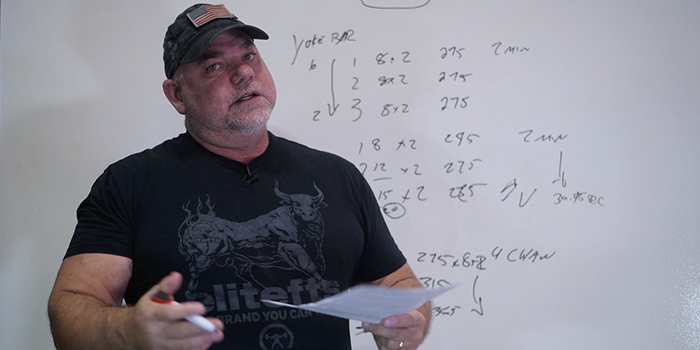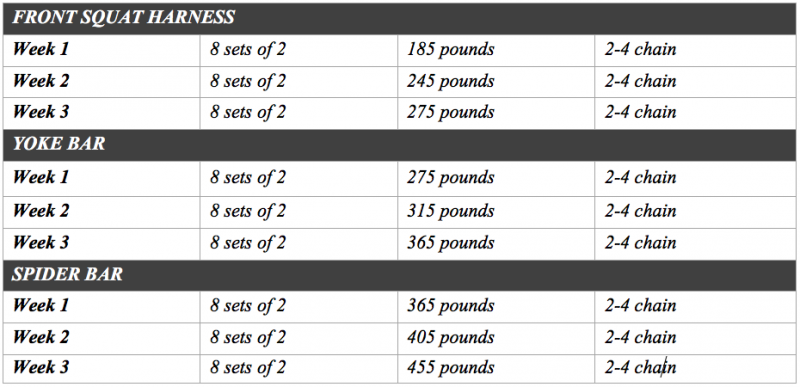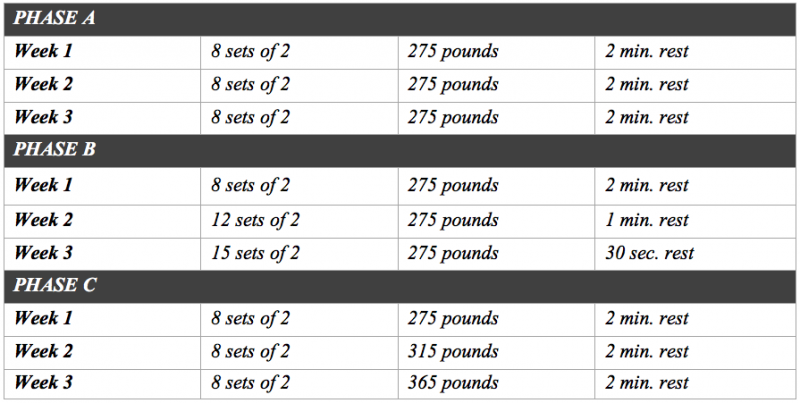
Over the course of the Fixing Dave Tate Series, Dave worked closely with Dr. John Rusin to undergo a holistic physical evaluation and implement a program to reduce his daily pain levels. His training as a part of this project incorporated elements of Dynamic Effort and Max Effort programming.
In this instructional video, Dave discusses the benefits of dynamic effort and max effort training and breaks down the specifics of his programming during his work with Dr. Rusin.
Benefits of Max Effort Programming
Dave added max effort programming back into his training a couple of years ago as a means to improve his joint stability. This type of training helps to develop inter-muscle coordination and teaches athletes and powerlifters how to stay coordinated while safely managing heavy weights. When max effort programming is executed within the proper parameters for an individual, joint stability will noticeably improve. This is especially important for Dave, who struggles with osteoarthritis and other injuries sustained over the course of his training career.
Benefits of Dynamic Effort Programming
When it comes to Dynamic Effort programming, Dave incorporates this into his training for two primary reasons. The first is for conditioning purposes, and the second is to help build maximum strength and rate of force development. For older athletes like Dave, executing dynamic effort programming likely won’t increase rate of force, but it can be used to maintain current capabilities to ensure that rate of force does not diminish over time.
Getting to the Starting Line
When Dave was first released back into training, he was unable to do max effort or dynamic effort work with any particular skill. At that point in time, his goal was to be able to achieve 135 across the board: 135-pound squat, 135-pound deadlift, and 135-pound bench press. According to Dave, if he cannot successfully execute this, then he is unable to get the proper blood circulation and movement to allow his body to recover.
“To me, a starting line would be when you can actually start training for something with purpose. Everything before that starting line is getting you ready and getting your body ready to be able to handle the training that you’re going to have to do… For me, I can’t just jump in and do standard Westside dynamic effort weights, I can’t do straight full max effort work…my body is not in a condition to recover from that.”
Once Dave is able to get to this “starting line”, he then sets his personal, overarching training objectives. Dave prefers to keep these objectives private, but mentions that he trains over the course of a two-year time span, working back from where he would like to be in two years as a means to structure his programming.
Dave’s Dynamic Effort Program
Dave describes his dynamic effort programming as a three-part series that consists of three-week “waves”. One of the first meaningful series that he executed, broken down in detail in the chart below, was exclusively using a Yoke Bar (as he can no longer get under a straight bar).
As illustrated above, Phase A of Dave’s dynamic effort programming was more about building the base that he needed to establish in order to do more explosive work. Phase B kept the same weight at 275 pounds, but increased the volume over time with the number of sets. While this also serves to increase the workload, that was not the objective; the primary goal was to decrease the rest time from two minutes down to 30-45 seconds during week three.
Finally, Phase C started to incorporate more of a “wave” in terms of weight and Dave began to use four chains. At the end of this phase, however, he started to experience knee issues, and therefore skipped his dynamic/max effort work for the next week. Instead, he focused his time on knee stabilization exercises that have been successful for him in the past (i.e. seated calf raises, TCE’s, etc.).
At this point in his program, Dave began to rotate different bars based on strength. As shown below, each wave increased the workload without having to change the volume. Similarly, although the workload is increasing significantly over the course of the programming, the intensity remains relatively constant. This is a demonstration of how specialty bars can be used to provide support — they help to alter the muscle and joint stimulus so the body can recover.

Dave’s Max Effort Program
Unlike dynamic effort work, max effort programming does not require athletes to plan as far in advance for this type of training. Instead, it can be auto-regulated over time based on individual needs. The key to max effort work is to change the exercises each week to allow enough time for recovery between high-weight sessions. At the beginning of his max effort training, Dave also purposefully reduced the tempo. This allowed him to still achieve the max effort straining that he needed, but in a controlled manner due to a more manageable speed.
“It isn’t the PR, it’s straining...Getting your body to strain is what’s going to make your absolute strength go up…The actual weight on the bar doesn’t matter as much as the strain…You do still want to build some kind of workload, but it’s a balance.”
In reflecting back on his work with Dr. Rusin, Dave acknowledges the importance of being able to auto-regulate his programming. Although he worked to address other weak points identified by Dr. Rusin, he emphasizes that it still remains crucial for individual athletes to adjust training parameters based on their body’s particular needs. This is especially true for someone like Dave, who has spent years of his life training – no one will ever know his body better than he does.











